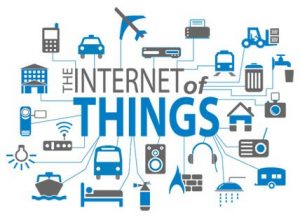
Internet of things (IoT) is the internetworking of physical devices, vehicles, buildings, and other items—embedded with electronics, software, sensors, actuators, and network connectivity that enable these objects to collect and exchange data.
As objects become embedded with sensors and gain the ability to communicate, the new information networks creates new business models, improve business processes, and reduce costs and risks.
Predictable pathways of information are changing: the physical world itself is becoming a type of information system. In Internet of Things, sensors and actuators embedded in physical objects —from roadways to pacemakers — are linked through wired and wireless networks that connects the Internet. These networks churn out huge volumes of data that flow to computers for analysis. When objects can both sense the environment and communicate, they become tools for understanding complexity and responding to it swiftly.
The IoT demands an extensive range of new technologies and skills that many organizations have yet to master. The technologies and principles of IoT will have a very broad impact on organizations, affecting business strategy, risk management and a wide range of technical areas such as architecture and network design. A few hot IoT technologies to keep an eye for now are:
Sensor driven decision analytics
– IoT business models will exploit the information collected by “devices” in many ways — for example, to understand customer behavior, to deliver services, to improve products, and to identify and intercept business moments. However, IoT demands new analytic approaches. New analytic tools and algorithms are needed now, but as data volumes increase, the needs of the IoT may diverge further from traditional analytics.
In health care, sensors and data links offer possibilities for monitoring a patient’s behavior and symptoms in real time and at relatively low cost, allowing physicians to better diagnose disease and prescribe tailored treatment regimens. Patients with chronic illnesses, for example, have been outfitted with sensors in a small number of health care trials currently under way, so that their conditions can be monitored continuously as they go about their daily activities.
Event Stream Process optimization
– The Internet of Things is opening new frontiers for improving processes. Some industries, such as chemical production, are installing legions of sensors to bring much greater granularity to monitoring. These sensors feed data to computers, which in turn analyze them and then send signals to actuators that adjust processes—for example, by modifying ingredient mixtures, temperatures, or pressures. Sensors and actuators can also be used to change the position of a physical object as it moves down an assembly line, ensuring that it arrives at machine tools in an optimum position (small deviations in the position of work in process can jam or even damage machine tools). This improved instrumentation, multiplied hundreds of times during an entire process, allows for major reductions in waste, energy costs, and human intervention.
Some IoT applications will generate extremely high data rates that must be analyzed in real time. Systems creating tens of thousands of events per second are common, and millions of events per second can occur in some telecom and telemetry situations. To address such requirements, distributed stream computing platforms (DSCPs) have emerged. They typically use parallel architectures to process very high-rate data streams to perform tasks such as real-time analytics and pattern identification.
IoT Standards and Ecosystems
– Although ecosystems and standards aren’t precisely technologies, most eventually materialize as application programming interfaces (APIs). Standards and their associated APIs will be essential because IoT devices will need to interoperate and communicate, and many IoT business models will rely on sharing data between multiple devices and organizations.
Many IoT ecosystems will emerge, and commercial and technical battles between these ecosystems will dominate areas such as the smart home, the smart city and healthcare. Organizations creating products may have to develop variants to support multiple standards or ecosystems and be prepared to update products during their life span as the standards evolve and new standards and related APIs emerge.